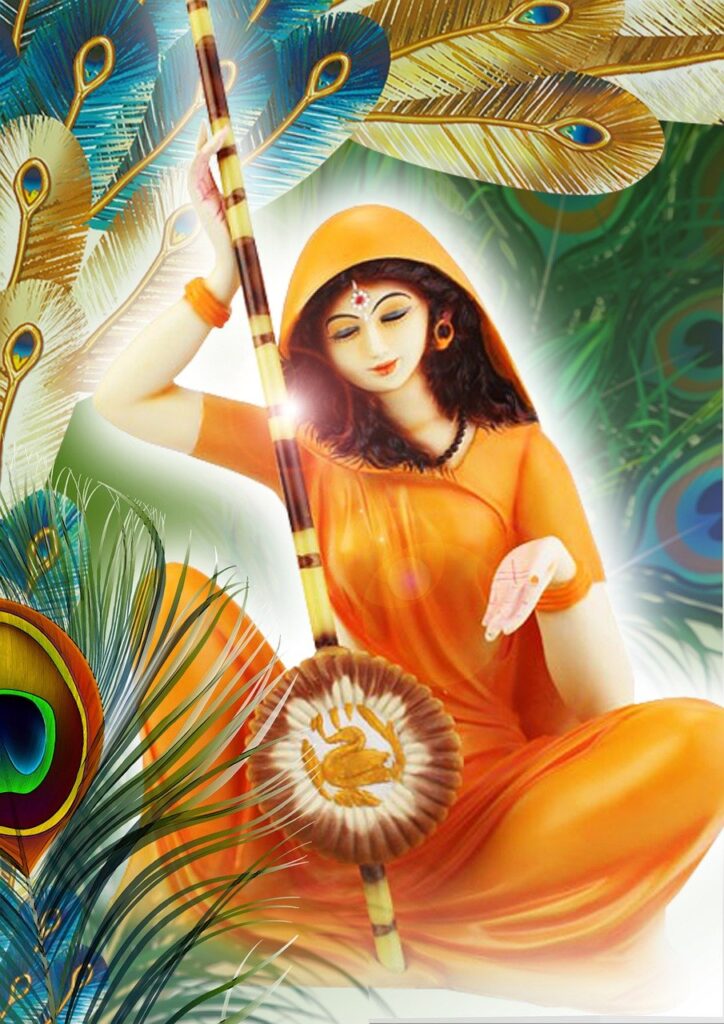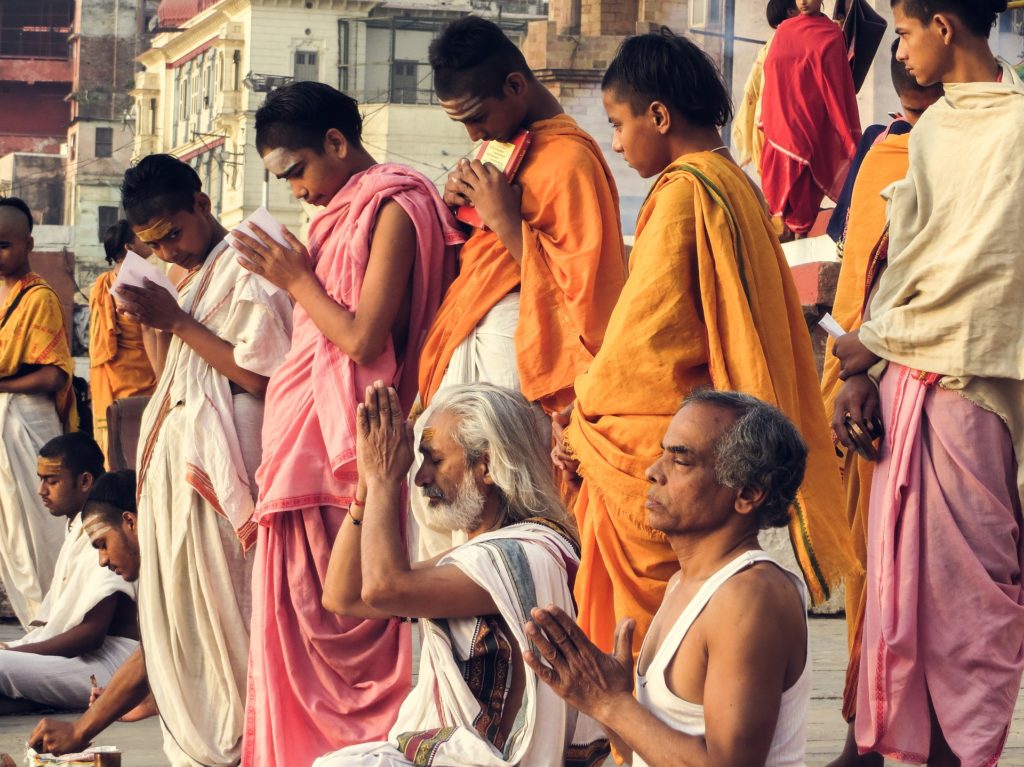
In Hinduism and the sacred texts of the Hindu faith, seven mothers are recognized. These mothers embody essential qualities of affection, empathy, nurturing, and at times, unwavering protection, crucial for the holistic development—both material and spiritual—of all entities. The following stanza by Chanakya Pandita enlists these seven revered mothers:
atma mata guroh patni
brahmani raja patnika
dhenur dhatri tatha prithvi
saptaita matarah smrtah
–
One’s own mother, the wife of the guru, the wife of a brahmana, the wife of a king, the cow, the nurse, and the earth are known as the seven mothers of a man.
In the following piece, our focus will be on exploring the concept of the seven mothers in Hinduism.
#1 Biological Mother
As the dynamic force of the Divine orchestrates the creation, sustenance, and transformation of the cosmic realm, the biological mother undertakes the role of nurturing, sustaining, and guiding us toward our better selves.
Beyond fulfilling our material needs, the extraordinary mother is also regarded as our first guru, dedicating herself to fostering and nurturing our spiritual evolution. Through her thoughts and deeds, she etches profound imprints onto a child’s consciousness, even during the gestation period, establishing a groundwork for spiritual triumph throughout life, regardless of the circumstances of birth.

A remarkable illustration of a mother shaping such impressions upon her unborn child can be found in the ancient Hindu scripture, the Bhagavat Purana (Srimad Bhagavatam). At one instance, when the power-hungry demon king, Hiranyakashipu, embarked on a journey of austerities in his quest for invincibility, his wife, Kayadhu, pregnant with their child Prahlad, was apprehended by the deities. Fearing the birth of a being who could potentially wreak havoc across the universe, the gods contemplated ending the child’s life upon birth. However, sage Narada intervened, comprehending the situation, and brought Kayadhu to his hermitage, where she found refuge until Hiranyakashipu’s return. Praying fervently for her unborn child’s safety, Kayadhu seized the opportunity of Narada’s guidance, wholeheartedly absorbing his spiritual teachings. Even in the womb, Prahlad imbibed the entirety of Narada’s wisdom. Consequently, upon his birth, despite being raised by a power-hungry ruler, Prahlad matured into a selfless individual and evolved into an illustrious devotee of Lord Vishnu. Afterward, Prahlad boldly confronted his demoniac father and found shelter in the divine guardianship of Lord Narasimhadeva, a half man-half lion incarnation of Lord Vishnu. He had incarnated to shield Prahlada and to triumph over the tyrant Hiranyakashipu.
#2 Wife of Spiritual master (Guru Patni)
In accordance with the Vedic customs, children around the age of five would traditionally be enrolled in a gurukul, an educational system from ancient India. Here, they would not only receive worldly education but, more significantly, spiritual instruction. Since this setup often entailed students residing within the guru’s abode, where the necessary discipline and framework for learning were furnished, the guru’s wife assumed a maternal role for the students. She extended her care and tenderness to these youngsters who were away from their parents, imparting the nurturing and affection requisite for their holistic growth.

In the Bhagavata Purana, we come across the account of how Krishna and Balarama were attentively looked after by Sandipani Muni and his wife. Within the annals of Gaudiya history, we discover the profound reverence bestowed upon Sita Thakurani, the wife of Advaia Acharya, and Jahnava Mata, the wife of Nityananda Prabhu, by the Gaudiya Vaishavas who regarded them as their maternal figures. Their guidance held immense significance and was promptly acted upon. This is vividly exemplified by Narottam Das Thakur, who invited Jahnava Devi to preside over the Kheturi festival, with the intention of harmonizing the philosophical divergences existing among the various branches of Gaudiya Vaishnavism.
#3 Wife of a Brahmana
The spiritual master holds the status of a Brahmana, although not all Brahmanas are formally acknowledged as educators of pupils. Some may pursue alternate vocations like conducting rituals, studying the Vedas, or guiding others in ritual practices. The spouses of these virtuous individuals should similarly be regarded with the reverence attributed to mothers.
A captivating narrative concerning the wives of Brahmanas is recounted in the Srimad Bhagavatam. Knowing that some brahmanas were engaged in a Vedic sacrifice nearby, a ritual that typically encompassed food preparation, Krishna instructed his companions to approach these sages and request a portion of the prepared food for their own consumption. However, when the cowherd boys went to make the request, they returned disheartened, as the sages had paid them no heed.

In response, Krishna directed his friends to make a second attempt, this time advising them to approach the wives of the brahmanas for food. Upon learning of Krishna and his friends’ hunger, the sages’ wives were overwhelmed with affection and empathy. Without hesitation, they gathered a bountiful feast and presented it to them. Even though their husbands had expressly forbidden them from carrying food, the Brahmanas’ wives disregarded this prohibition and brought nourishment for Krishna and Balarama. Through this act of offering food to Krishna, they attained the pinnacle of their spiritual journey, achieving supreme perfection in their lives.
#4 Wife of a King (Raj Patni)
Tasked with fostering a social environment conducive to both material and spiritual advancement, a model ruler in Vedic India garnered reverence not merely as a monarch, but also as a paternal figure to the populace. Consequently, the queen assumed a revered maternal role, extending her care to the kingdom’s inhabitants as her own offspring. This approach inspired and supported the king in enacting policies that upheld the holistic well-being of all. Throughout Indian history, numerous courageous queens have valiantly fought for the betterment of their subjects. One such remarkable individual was Rani Lakshmibai, the wife of Maharaja Gangadhar Rao Newalkar and the reigning queen of the princely state of Jhansi within the Maratha Empire from 1843 to 1853. Her active participation in the Indian Rebellion of 1857 elevated her to the status of a national hero, embodying the spirit of resistance against British colonial rule in India and serving as an enduring emblem for Indian nationalists.

#5 The Cow (Dhenu)
Namo brahmanya devaya
Go brahmana hitaya ca
Jagad dhitaya Krsnaya
Govindaya namo namah
(Vishnu Purana 1.19.65)
–
I offer my obeisances again and again to Lord Krishna, who is always worshiped by qualified brahmanas and is very dear to them. He is always concerned with the welfare of the cows, the brahmanas, and the whole world. I offer my repeated obeisances unto the Personality of Godhead, known as Krishna and Govinda.
The Vishnu Purana’s mantra pays homage to Lord Krishna, shedding light on his exalted status among revered Brahmanas. This invocation underscores his close bond with qualified Brahmanas, indicating their profound reverence for him. It also highlights his genuine care and concern for the welfare of cows, Brahmanas, and the entire world, portraying Krishna as a compassionate protector of all life. Krishna’s inseparable connection with cows is deeply rooted in his original form as a cowherd boy in the spiritual realm of Goloka Vrindavan. When Krishna descends to the material world, he carries the essence of this pastoral life with him. Throughout his childhood, Krishna can be found tending to cows and calves, engaging in playful activities amidst the pastures of Govardhan with his companions. His close relationship with cows is reflected in his knowledge of each cow by name, emphasizing their significance in his life.

The Vedic society holds cows in high esteem, recognizing their vital contributions to human life. Cows are revered as mothers in Hinduism. Cows are pivotal in Vedic rituals, contributing essential products like milk, yogurt, butter, cow dung, and cow urine. These products are utilized in various ceremonies and are integral to the worship of deities. The Bhagavad Gita reveals Krishna’s wisdom on the role of Vaishyas, who were encouraged to engage in activities aligned with their natural tendencies, including cow protection and utilizing cow products. This approach signifies the importance of a harmonious relationship between humanity and cows in an agricultural economy. Cows were not just sources of material sustenance but also carried profound spiritual significance. The Rig Veda and other Vedic scriptures explicitly advocate for the protection and reverence of cows. The Manu Samhita emphasizes non-violence towards animals, while the Mahabharata underscores the karmic consequences of harming them.
In traditional practice, once a cow gave birth and began producing milk, the calf would stay with its mother for approximately two weeks, nourishing itself as required. After this initial period, the excess milk produced by the cow would be available for human consumption. This approach allowed the ancient Indian populace to graciously acquire and utilize milk while also honoring the calf’s necessities and well-being, without indulging in any kinds of exploitation.
#6 The Nurse (Dhatri)
It’s evident that individuals who provide care during vulnerable or sick moments—whether they’re doctors, nurses, family members like daughters, sons, sisters, nephews, nieces, or others—deserve profound gratitude. While the gender dynamics might differ in modern times due to evolving roles, the essence of respect remains unchanged. Nurses, even if underappreciated, offer indispensable aid. Despite facing irritable or uncooperative patients, they persevere in their duties.
In Sri Krishna’s era, the term “nurse” could refer to someone who provided breast milk. An instance is Putana, who arrived in Vrindavana in disguise to poison baby Krishna. Her entry into Yashoda’s home was facilitated by the community’s inherent kindness. Nursing children not biologically their own was likely a norm.

Krishna’s encounter with Putana exemplifies this. Despite her sinister intentions, he granted her liberation. Though a witch, her conscious connection to the Supreme Lord during her demise led to her salvation. Krishna’s action demonstrated respect for the nurse’s role, akin to that of a mother.
#7 Mother Earth (Prithvi)
Referred to as Bhumi Devi, the earth embodies a divine presence. This implies that an intelligent entity oversees the material components composing the planet. The analogy of earth as a mother is not restricted to Vedic practices, as it’s only natural to hold reverence for the provider of all. Earth epitomizes resilience, as she endures immense trials yet continues to yield abundant harvests. Vital for sustaining existence, she is a life-giver akin to a mother, supplying all essential seeds for perpetuating life.

In a significant Vedic pastime, Varaha Deva, the incarnation of Vishnu, valiantly defended the earth from the demoniac Hiranyaksha. In this tale, Varaha Deva emerged as a boar to rescue the earth, who had been submerged deep into the cosmic ocean by Hiranyaksha. His triumphant feat exemplifies the protective nature of the Supreme Lord towards the earth, further affirming her revered status as a life-giving motherly figure.
A Poem for the Seven mothers
In Hinduism’s embrace and sacred texts, a gem unfolds,
Seven mothers revered, their roles beautifully told.
They embody love, empathy, care, protection’s might,
Nurturing all beings, in both day and night.
Chanakya’s stanza enlists these noble mothers’ grace,
Their significance woven in life’s intricate embrace.
The biological mother, first in the line,
Nurturing and guiding, a love so divine.
The guru’s wife, like a mother, stands,
Guiding students’ growth with tender hands.
Brahmana’s spouse, revered as a mother too,
Her wisdom and virtues, like morning’s dew.
The queen, a maternal figure for the realm she leads,
Guiding her people, fulfilling their needs.
Cows, life’s givers, in Krishna’s embrace,
Sustaining with milk, love’s eternal grace.
Nurses, caregivers, their love unending,
Even in discomfort, their care’s transcending.
Mother Earth, provider of life’s embrace,
Nurturing beings in a harmonious space.
Varaha Deva’s valor, a tale of old,
Protecting Earth, his love manifold.
In Hinduism’s tapestry, these mothers shine,
Guiding us all, with love divine.